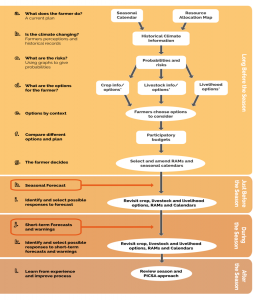These are a set of resources for field staff to help them implement PICSA with farmers. They should be used alongside the PICSA Manual.
Overview of PICSA
This presentation describes the PICSA approach, including its development and the countries in which it has been implemented. It goes on to explain the overall aims of PICSA and the step-by-step approach.
PICSA Approach Diagram
This diagram shows the different components of PICSA and how they all fit together to help farmers’ planning and decision-making. It also includes the two key principles of PICSA. It may be explained as follows:
- PICSA places farmers at the very centre of its approach. Farmers face significant challenges and opportunities that are associated with climate and weather, as well as other physical, social and economic factors
- The PICSA approach introduces climate information to farmers in the form of both historical climate data and seasonal and short-term forecasts.
- PICSA also helps farmers to consider locally available crop, livestock and livelihood options that could help them to deal with the challenges and opportunities they face.
- Finally, PICSA uses participatory decision-making tools to combine these elements and help farmers to make informed decisions.
- The principle of the ‘The Farmer Decides’ emphasises that farmers are best placed to make decisions about their agricultural practices, because they have detailed knowledge of their farm, system and environment, and they also face the consequences (whether favourable or unfavourable) of their decisions.
- The principle of ‘Options by Context’ recognises that different farmers work in different contexts (such as climate, land, assets, ambitions, and attitudes to risk). They should therefore make decisions that work best for their individual households.
PICSA Flow Chart
This diagram outlines all of the PICSA steps, beginning long before the season, continuing through the build-up to the season and during the season, and then ending after the season has finished. It shows the aim of each step, as well as how the steps all fit together as a whole. It can be used as both a reminder of the PICSA process for field staff, and for showing an overview of the process to farmers.

Suggested PICSA Training Schedule
This flow chart suggests a schedule that field staff may use for planning PICSA training sessions with farmers. It spreads the PICSA steps across 4 meetings and outlines which activities may be covered during each one. It also includes the communication of short term forecasts, which should happen as frequently as possible during the growing season. Additionally, it features the Planning and Review meeting, which reviews progress on PICSA implementation and plans for the communication of Seasonal and Short-term forecasts. This should be held early enough for farmers to adapt their plans, but late enough for Steps A-G to have been completed. This resource should be used in combination with the PICSA Flow Chart.
Suggested PICSA Training Schedule (pdf)
Work Plan for Extension Workers
The aim of this resource is for field staff to plan the PICSA training sessions that they will conduct with farmers. It should be used in combination with both the PICSA Flow Chart and the PICSA Training Schedule. Field staff can use this to plot the dates of training sessions, as well as which steps they plan to cover and how many farmers they will meet in each session.
Work Plan for Extension Workers (pdf)
Monitoring Form
The Monitoring Form should be completed by field staff at the end of every PICSA training session that they conduct with farmers. It helps them to keep track of the activities that they conducted with farmers, as well as any useful observations that they made.
Farmer Questionnaire 1
This questionnaire is designed for monitoring purposes and should be filled in by farmers after the completion of Steps A-G. It also helps to understand and improve the PICSA approach.
Farmer Questionnaire 2
This questionnaire is designed to help evaluate the PICSA approach and should be completed by farmers at the end of the growing season. It aims to assess how useful the farmers found the PICSA training, as well as to find out about any suggestions they have for its improvement.
Rainfall Data Collection Diagram
This diagram illustrates the process of collecting the rainfall data that is included in the historical climate information. It is helpful to explain this process to farmers so that they can connect the data with real life.
